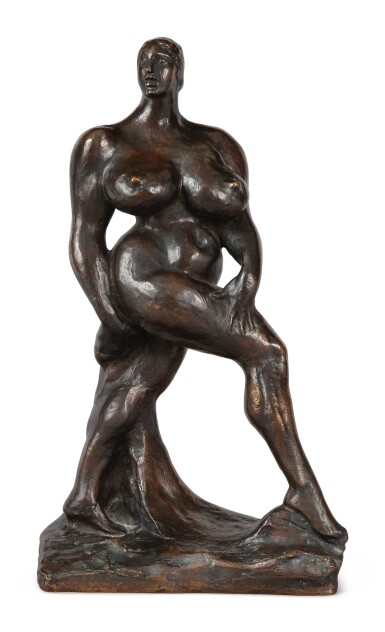
GASTON LACHAISE | WOMAN (STRIDING WOMAN)
Lot Closed
September 30, 06:11 PM GMT
Estimate
30,000 - 50,000 USD
Lot Details
Description
GASTON LACHAISE
1882 - 1935
WOMAN (STRIDING WOMAN)
numbered 4/11 and stamped LACHAISE / ESTATE (on the base) and MODERN ART FDRY. N.Y. (along the base)
bronze with dark brown patina
height: 17 ¾ inches (45.1 cm)
Modeled in 1928-31; cast circa 1974.
We are grateful to Virginia Budny, author of the forthcoming catalogue raisonné sponsored by the Lachaise Foundation, for preparing the catalogue entry for this work.
Lachaise Foundation, Boston, Massachusetts, circa 1974
[with]Robert Schoelkopf Gallery, New York, by 1975
Gerald Peters Gallery, New York, 1980 (acquired by from the above)
Acquired by the present owner from the above, 1988
Hyatt Mayor, “Gaston Lachaise,” Hound & Horn, vol. 5, no. 4, July - September 1932, following p. 564, plaster model illustrated
Museum of Modern Art, Gaston Lachaise: Retrospective Exhibition, New York, 1935, p. 26, no. 35, fig. 35, plaster model illustrated
Thomas B. Hess, “Gaston Lachaise,” Art News, vol. 45, no. 11, January 1947, pp. 20–21, another example illustrated
Knoedler & Company, Gaston Lachaise, 1882-1935, New York, 1947, p. 17, no. 26, pl. 26, another example illustrated
D.B. Goodall, "Gaston Lachaise, Sculptor," Ph.D. dissertation, Harvard University, 1969, vol. 1, pp. 580, 662, no. 28, vol. 2, pp. 321-22, 435, pl. CXLI, plaster model illustrated (as Striding Nude)
Herbert F. Johnson Museum of Art, Cornell University, Gaston Lachaise, 1882–1935, exhibition catalogue, Ithaca, New York, 1974, n.p.
G. Nordland, Gaston Lachaise: The Man and His Work, New York, 1974, pp. 162-63, fig. 90, another example illustrated
Robert Schoelkopf Gallery, New York, ARTnews, vol. 74, no. 5, May 1975, p. 72, illustrated
San Bernardino California State College, The Art Gallery, Gaston Lachaise: Sculpture and Drawings, San Bernardino, California, 1980, pp. 34, 38, 50, no. 26, figs. 44a-44b, another example illustrated
Palm Springs Desert Museum, Gaston Lachaise: 100th Anniversary Exhibition, Sculpture and Drawings, Palm Springs, California, 1982, pp. 31, 34, 43, no. 49, another example illustrated
Robert Schoelkopf Gallery, Gaston Lachaise: Twenty Sculptures, New York, 1982, n.p., plaster model illustrated
Marlborough Gallery, Masters of Modern and Contemporary Sculpture, New York, 1984, n.p., no. 32, another example illustrated
Salander-O’Reilly Galleries, Gaston Lachaise: Sculpture, New York, 1991, pp. 36-37, 82, no. 12
E. Shepherd Burlingham, In the Sculptor's Landscape: Celebrating Twenty-Five Years of the Franklin D. Murphy Sculpture Garden, Los Angeles, California, 1993, pp. 55-56, 108, no. 33, fig. 39, another example illustrated
Sam Hunter, Lachaise, New York, 1993, pp. 131-33, 243, another example illustrated
Cedar Crest College, Proceedings from a Conference on the Work of Lachaise, Allentown, Pennsylvania, 1996, pp. 10, 26, no. 45, another example illustrated
Salander-O'Reilly Galleries, Gaston Lachaise, New York, 1998, n.p., no. 39, another example illustrated
According to Gaston Lachaise, the model for this statuette of a powerful-looking nude was created in 1928-31. The artist chose to include the plaster model for the work in his 1935 retrospective exhibition at the Museum of Modern Art, New York, as an example of his most important sculptures, and when the work was first cast in bronze for his posthumous retrospective exhibition at the Knoedler Gallery, also in New York, in early 1947, it was hailed by critic Thomas B. Hess as “one of Lachaise’s masterpieces” (Art News, vol. 45, no. 11, January 1947, p. 20). Lachaise’s own name for the statuette is Woman, yet the work has misleadingly become known in the 1960s as Striding Nude, and afterward, Striding Woman. In fact, in a way reminiscent of a burlesque dancer’s provocative pose, the nude has advanced one leg so as to display her thigh prominently while turning to present her breasts proudly to the beholder.
The statuette exhibits the more muscular and robust figure style that Lachaise had begun to explore in 1928, and then fully demonstrated in his contemporaneous, paired statues, Standing Woman [LF 92] (modeled 1928-30, cast late 1932 or 1933; Museum of Modern Art, New York) and Man [LF 85] (modeled 1928-30, revised 1933/34-35, cast 1938; Chrysler Museum of Art, Norfolk, Virginia). For Lachaise, his newly enhanced heroic style enabled him to express even more forcefully than before his guiding personal vision of the extraordinary vitality of life in America, and its unmatched potential to promote an individual’s healthy sexual, personal, and creative fulfillment. In all of these new works, he emphasized the torso, which he considered to be the most important part of the body, treating it as the potent source of a supercharged energy.
The first bronze cast of Woman (Striding Woman) [LF 126] was authorized in 1946 by Lachaise’s widow, Isabel Nagle Lachaise (1872-1957). That cast has not been documented after it was exhibited in the following year. From 1973 to 1992, an edition of eleven numbered casts, including the present example (ordered in 1974), were issued by the Lachaise Foundation, which had been established in 1963 to administer the artist’s estate, and which owns the plaster model for the work.
